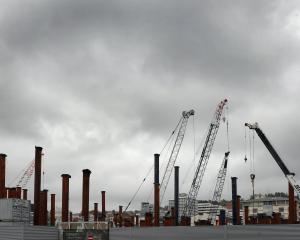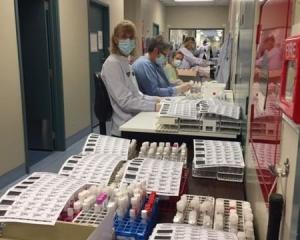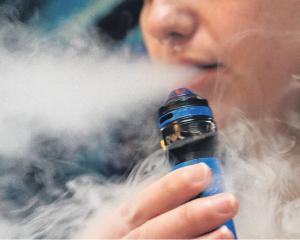
It was meant to offer greater support and security to midwives and give confidence to new and expecting mothers.
Instead, it sparked protest marches, petitions and questions in Parliament, and has been blamed for a Lumsden woman giving birth in an ambulance and a Wanaka woman's child arriving in her midwife's office.
The Southern District Health Board's maternity services review angered some midwives and has left many rural women uncertain whether their babies will be delivered safely.
What was in place before?
District health boards are contracted by the Ministry of Health to provide healthcare in accordance with the ``service coverage schedule'', a document central to what follows.
When the southern health board began its maternity services review, Southland and Dunedin hospitals were supported by seven regional primary birthing units and two maternal and child hubs.
The schedule dictates what services must be in place to serve communities with 100 or 200 pregnancies annually which are 60 or 30 minutes respectively from a hospital.
The timings were and still are contentious, plan opponents arguing they do not account for rural roads and the South's winter weather.
Southern covers the greatest area of any health board - at more than 62,000sqkm it is the size of Scotland, and has many far-flung communities to provide health services for.
Where those people live has changed markedly.
In 1996, a year before the Charlotte Jean Maternity Hospital opened in Alexandra, Central Otago was home to 16,000 people, while the Queenstown Lakes region had a resident population of 8000.
By the 2013 census, only 2000 more people lived in Central, but 20,000 more people called the Lakes region home.
Stats New Zealand population projections, released yesterday, put the Queenstown Lakes district population at more then 50,000 by 2028, while Central Otago's population is projected to be about 24,000.
The board described the maternity services system as ``the legacy of historic and piecemeal decisions'', and said it wanted to replace it with a sustainable plan which met the needs of the entire district.
What happened next?
The health board set up a primary maternity project in 2016, which took earlier discussions with clinicians and midwives and then held a series of consultation meetings.
Having identified three key concepts - a sustainable district-wide network of providers; the importance of primary birthing facilities; and services being sited to meet the changing needs of the population - workshops were then held, followed by another series of regional meetings.
In the meantime, the board was also drawing up its primary and community health strategy, a document which envisages a future in which services become centred in integrated healthcare ``hubs''.
The plan also calls for greater use of technology to deliver healthcare to remote locations, an aspect also picked up by maternity service planners as an aid for women in remote areas.
The health board then
rolled out its draft maternity plan for consultation, a document it said met
Ministry of Health birthing population standards, provided equity for disadvantaged communities and addressed concerns regarding travel distances.
New maternal and child hubs would be set up in Wanaka and Te Anau, and the Lumsden Maternity Centre would be reduced from a primary birthing unit to a maternal and child hub.
So, everyone was happy?
No, far from it.
Consultation yielded 216 responses, the majority from furious Lumsden residents determined to retain their primary birthing unit.
Wanaka residents were also vocal, wanting their planned hub to be upgraded to a birthing unit - something the health board said it would examine as part of further consideration of maternity services in Central Otago.
Lumsden has proven the most contentious issue, and residents are still fighting a rearguard action there.
Central to their argument has been the service coverage schedule, residents arguing the board used the number of births at the centre to make its decision rather than pregnancy rates, as mandated by the schedule.
With the exuberant backing of local MP Hamish Walker, whose petition calling for the Lumsden Maternity Centre to be saved is still being considered by Parliament's health select committee, the issue hit the national political agenda.
Health Minister David Clark asked ministry officials to double-check the health board's work; their view was that the board had followed proper process in considering compliance with the schedule.
Then, after the recent roadside birth, Prime Minister Jacinda Ardern was dragged into the issue; she said she had looked at the issue earlier and was happy to look at it again.
In Wanaka, support groups campaigning for more midwives and services for the town have been particularly vocal as well. After a baby was born on the floor of a midwife's office and a Wanaka women had to be flown to Dunedin Hospital, leaving her husband to drive their 3-hour-old baby to the city, the cries became roars.
In the meantime, maternal and child hubs have been set up, or are in the process of being set up - which has sparked a whole new controversy as to whether they have been, or will be, properly equipped and set up in time for the transition.
What happens next?
A review of Central Otago maternity services is ongoing, but in the meantime the health board this week announced the home of the new Wanaka hub.
This seems to have placated some of the concerns in that town, though the new ``hub'' is not near the helicopter pad, medical centre or midwives' offices, and will not be up and running until next year.
Whatever comes from Ms Ardern taking another look at the Lumsden issue is yet to be seen, but the health board has said it would review the implementation of the strategy.
The health select committee will soon vote on Mr Walker's petition; its membership is split evenly between National and Government MPs, but local political issues are in play for Invercargill Labour list MP Liz Craig and Central Otago New Zealand First MP Mark Patterson, who has sat on the committee for this petition.
If the committee backs the petition, it is likely that will lead to another review of the health board's decision-making process.
If it does not, there seems little chance of this bitter debate ending anytime soon.












